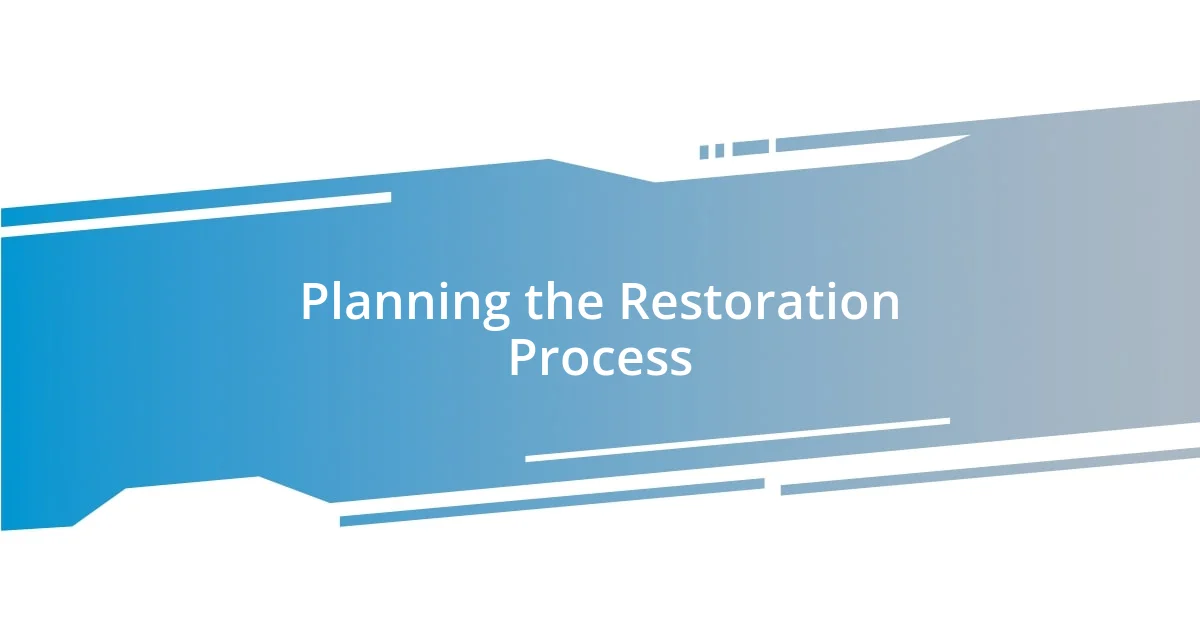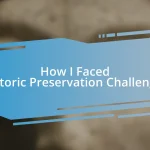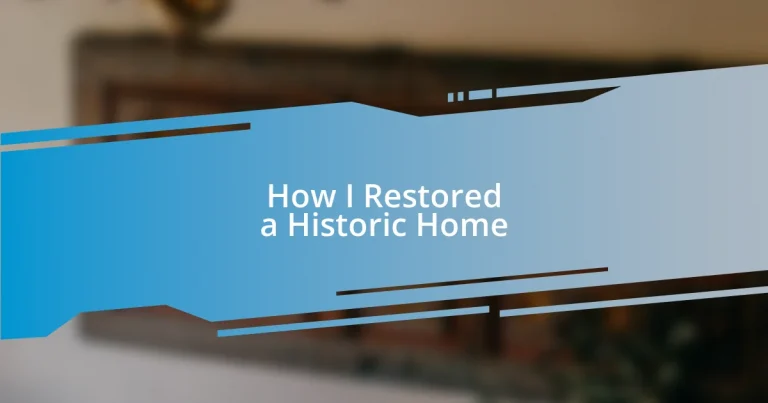Key takeaways:
- Restoration is a blend of passion and preservation, requiring deep research and planning to honor a historic home’s unique character.
- Creating a detailed assessment of the home’s condition, including both exterior and interior elements, is crucial for prioritizing repairs and understanding preservation needs.
- Final touches emphasize the importance of selecting elements that reflect the home’s historical essence, transforming it into a space that embodies both history and personal narratives.

Introduction to Historic Home Restoration
Restoring a historic home is a journey that intertwines passion, preservation, and personal tales. I remember stepping into my own project and feeling a rush of excitement mixed with a pinch of fear—would I do justice to its storied past? Each chipped plaster and creaky floorboard whispered stories from another time, igniting a desire within me to honor every detail.
What draws so many people, including myself, to historic restoration is the profound connection to our shared heritage. It’s like being a custodian of history, unearthing the skeletons of the past to breathe new life into them. Have you ever stood in a space and felt the weight of its history? In those moments, I often reflect on the lives once lived there and the responsibility of preserving that legacy for future generations.
As we dive deeper into the ins and outs of restoring a historic home, it’s crucial to remember that each structure has its own identity and character. I learned early on that this process goes beyond mere renovations—it encompasses research, planning, and a fair bit of patience. Understanding the architectural style and period specifics can transform the experience, turning it into a labor of love where every brushstroke and nail placement contributes to a narrative much larger than ourselves.

Assessing the Home’s Condition
Evaluating the condition of a historic home requires a careful look at both its exterior and interior features. I remember the first time I walked around the outside of my home, peering closely at the original clapboard siding. What struck me was how the weathered boards told their own tale—patchy paint and fading color seemed to reflect decades of sun and rain. I realized that each imperfection was not a flaw but a marker of history that needed preserving.
Inside, the process was just as revealing. I pulled back carpets to reveal original hardwood floors, and my heart raced at the thought of protecting those pieces of craftsmanship. A thorough inspection of the ceiling and walls also helped uncover any hidden mold or structural issues. This part of the journey was both daunting and exhilarating. With every creak of the floor, I felt a connection to those who had walked there before me, reminding me of the importance of honoring the home’s integrity.
Creating a detailed assessment checklist can streamline this evaluation process. As I tackled my project, I discovered that focusing on key elements helped me prioritize repairs effectively. This approach turned assessing the condition into a structured yet impactful part of the restoration, giving me clarity on what needed immediate attention versus what could wait.
| Assessment Aspects | Details |
|---|---|
| Exterior Condition | Look for signs of wear, paint peeling, and structural damage |
| Interior Elements | Inspect flooring, walls, and ceilings for integrity and moisture issues |
| Historical Features | Identify original components to preserve, like moldings or fixtures |
| Foundation Checks | Assess for cracks or settling that may require professional input |

Planning the Restoration Process
Planning a restoration journey is where your vision starts to take shape. When I embarked on my home project, I remember sketching out a detailed blueprint; it felt like mapping out my dreams. I realized that having a solid plan could mean the difference between chaos and a rewarding experience. I often advise starting with research to fully understand the history and architecture of your home, allowing you to make informed decisions throughout the process.
Here’s a handy checklist to guide you through the planning phase:
- Research the Home’s History: Delve into local archives and records to uncover its past.
- Set a Budget: Allocate funds for materials, labor, and unexpected expenses, as costs can escalate quickly.
- Establish Priorities: Determine which elements require urgent attention and which can be phased in later.
- Consult Professionals: Engage historians or architects familiar with your home’s style to provide guidance.
- Create a Timeline: Set realistic deadlines for each phase of the project to keep yourself focused and motivated.
Reflecting on my experience, I found that a realistic timeline kept me grounded. There were moments I felt overwhelmed, but checking tasks off my list provided a satisfying sense of progress. Each step taken was not just towards restoring a house, but towards building my dream home, one thoughtful decision at a time.

Budgeting for the Restoration
Budgeting for my home restoration journey was both thrilling and intimidating. I recall sitting at my kitchen table, armed with a spreadsheet and a cup of coffee, mapping out every possible expense. It struck me how easy it is to get caught up in the excitement of restoration, only to forget about the hidden costs lurking behind those charming details—like finding rotting beams behind beautiful reclaimed wood paneling or the sudden need for updated electrical systems.
As I developed my budget, I learned to prioritize. Initially, I was tempted to splurge on high-end fixtures, but that epiphany hit when I remembered the importance of structural integrity. I made the tough decision to allocate more funds for foundational work instead. In my experience, your budget needs to be flexible; it’s a guideline, not a strict rule. Have you ever found unexpected expenses derail your plans? I certainly have, but being prepared for those surprises kept my project from becoming a financial nightmare.
To ensure I stayed on track, I built in a contingency fund. It’s like a little safety net for when the universe throws those unforeseen curveballs your way. I remember the relief of having that buffer when I unearthed issues in the plumbing. As I navigated through the projects, journaling my expenses and reflecting on my financial decisions also became essential. It turned my budgeting process from a chore into an engaging experience, almost like storytelling through my home’s financial journey.

Sourcing Authentic Materials
Sourcing authentic materials was one of the most exhilarating aspects of restoring my historic home. I vividly remember wandering through antique shops and flea markets, searching for that perfect period-appropriate window to match the home’s original aesthetic. It felt like a treasure hunt, each find rewarding not just for its beauty, but for the connection to the home’s history that it represented. Have you ever stumbled upon an item that felt like it belonged in a specific place? I certainly did when I uncovered a salvaged front door—the moment it swung open, I could almost hear the stories of the families who had passed through it.
I quickly learned that building relationships with local suppliers and artisans proved invaluable. One charming lumberyard owner had a wealth of knowledge about reclaimed wood and its history, which he eagerly shared as I sifted through his collection. Listening to his stories made me feel more grounded in the heritage of my home, connecting me to the very essence of its past. It’s easy to overlook the emotional weight of materials, but sourcing these authentic pieces placed significance on every element of the restoration. How can you quantify the joy of finding a vintage doorknob that could tell tales if it could speak?
In my journey, I also faced challenges. Some materials were difficult to source, leading me to alternative options that still captured the spirit of the original design. I remember being torn over a decision to choose a modern tile over the elusive hand-painted ones I had initially wanted. Ultimately, I chose a blend that honored the home’s character while accommodating my budget. It was a reminder that authenticity can manifest in various forms; sometimes, it’s about the narrative behind each piece rather than the item itself. The thrill of sourcing authentic materials turned into an integral part of my restoration story, shaping not just the home, but my connection to it.

Navigating Local Regulations
Navigating local regulations was one of the most daunting parts of my restoration journey. I remember attending a town hall meeting, feeling a mix of excitement and anxiety as I listened to the zoning laws and historic preservation guidelines laid out before me. It was a real eye-opener, realizing how much red tape could stand between my dreams and the reality of restoring my home. Have you ever felt overwhelmed by rules that seem to stifle your creativity? I certainly did, but understanding those regulations was crucial for my project’s success.
Throughout the process, I learned the importance of open communication with local officials. I made a habit of scheduling informal chats with my town’s preservation board. Each conversation left me with valuable insights and often a clearer understanding of what modifications would be permissible. I even felt a sense of camaraderie build with the officials—a reminder that they were not just enforcers of the law but also passionate advocates for preserving our community’s heritage. It was like having a guide on an unfamiliar path; once I knew the rules, I could navigate them confidently.
Moreover, I encountered strict guidelines regarding the materials I could use, particularly when it came to roofing and siding. I’ll never forget the moment I received a denial for my first choice of modern shingles; it felt disheartening at first. However, I kept my mind open to alternatives and eventually found beautiful cedar shakes that not only adhered to regulations but also complemented my home’s historical character perfectly. This process taught me that while regulations can be challenging, they often lead to solutions that enhance the overall vision. Wouldn’t you agree that sometimes the best outcomes arise from unexpected obstacles?

Completing the Final Touches
Completing the final touches on my historic home felt like adding the exclamation point to a long-awaited story. I remember standing in the living room, looking at the freshly painted walls, and feeling that exhilarating mix of pride and nervousness. How do you encapsulate years of hard work into simple, finishing details? For me, it was about choosing the perfect light fixtures that not only illuminated the space but also echoed the home’s period charm. I stumbled upon a set of antique brass sconces at a local shop, and the moment I hung them, the room transformed. It was like breathing life into my vision.
As I moved from room to room, I realized how essential the little things are—the doorknobs, the trim, the color on the walls. Each element contributed to the overall feel of the home, reinforcing its character and inviting a sense of warmth. I found myself meticulously selecting paint colors that whispered stories of the past. After much deliberation, I painted the dining room a rich, deep green, reminiscent of the period when my house was built. Have you ever taken a step back and felt that a space radiated its own energy? That’s precisely how I felt, with every stroke of the brush embedding history in a contemporary way.
Ultimately, the final touches were filled with bittersweet emotions. As I added the last few pieces of decor, I recognized that this journey was coming to an end—and it was nearly overwhelming. I remember setting a vintage mirror from the flea market in the hallway and reflecting on all that had changed. It seemed fitting to pass my care and intention forward, preserving not only the house but also the stories it would continue to hold. Isn’t it incredible how a few thoughtful details can transform a house into a home, allowing history and personal narratives to blend seamlessly?












